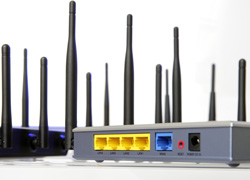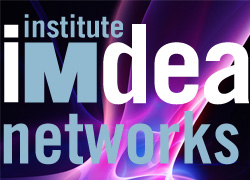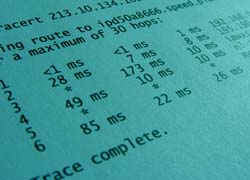IMDEA Networks

Archives: Events
Networked 3-D Virtual Collaboration in Science and Education: Towards ‘Web 3.0’ (A Modeling Perspective)
Combined advances in high speed networking, mobile devices, application sharing, web services, virtual world technologies and large scale event processing are converging to create a new world of pervasive, ubiquitous “presence” of users, which offers tremendous potential for social interaction and co-creation. The communication networking and computing requirements of this converged human-centric environment are also increasing at an accelerated pace. In this new environment, it is imperative that the much-needed networking and computing resources align closely with the needs and patterns dictated by the applications, social networks, and by the human users. We believe that the success of such socio-technical systems will hinge on the way networks capture and interact with human presence and location, in all of its physical, virtual and perceived aspects.
Read more arrow_right_altRouting and capacity resilient network design
Despite the broadly title, the seminar will be focused in the notion of max-min fairness (MMF) and its application to routing optimization in communication networks:
1. Basic notions
2. Convex MMF problems
3. Non-convex MMF problems
4. Examples of MMF routing optimization problems
Networking Future with IMDEA Networks
- Dr. Sergey Gorinsky (Senior Researcher, IMDEA Networks)
- Prof. Dr. Arturo Azcorra (Director General for Technology Transfer and Entrepreneurial Development (Spanish Ministry of Science and Innovation)
- Paul Patras (Research Assistant, IMDEA Networks)
- Dr. Mary Luz Mouronte (Division Manager, Telefonica Research, Madrid)
- Dr. Albert Banchs (Deputy Director, IMDEA Networks; Associate Professor, UC3M)
- Prof. Dr. Narasimha Reddy (Cátedra de Excelencia, University Carlos III of Madrid; Visiting Researcher, IMDEA Networks, Madrid; Texas A&M University, USA)
- Alejandro Javier Tosina González (Spanish Representative in ICT Committee – EU Framework Programme; CDTI – Ministry of Science and Innovation)
Location: Basement Floor, “Sala de Audiovisuales”, Room 3.1.S08, Building: Rey Pastor (Library), University Carlos III of Madrid, Avda. Universidad, 30, 28911 Leganes – Madrid
Date: November 11th, 2009, 15:00 – 18:00
Organization: IMDEA Networks in collaboration with the Higher Polytechnic School, University Carlos III of Madrid, Leganes Campus
The conference will be conducted in English
Advanced registration: rebeca.demiguel imdea.org
Presentation of research lines
Dr. Kenichi Mase, Dr. Toshini Tsuboi and Dr. Hiromi Ueda will visit Institute IMDEA Networkson Monday September 20th and will take the opportunity to present their research lines. The overall talk will last about 45 minutes, including questions and answers, and it will be divided in the following three 15 minute slots:
Read more arrow_right_altAn Algebraic Approach to Internet Routing
A great deal of of interesting work was done in the 1970s in generalizing shortest path algorithms to a wide class of semirings also called "path algebras" or "dioids". Although the evolution of Internet Routing protocols does not seem to have taken much inspiration from this work, recent "reverse engineering" efforts have demonstrated that an algebraic approach is very useful for both understanding existing protocols and for exploring the design space of future Internet routing protocols. This course is intended teach participants the basic concepts needed to understand this approach. No previous background will be assumed.
Read more arrow_right_altNetworking and Meaning of Life First IMDEA Networks Workshop on Far-Out Ideas
The first Workshop on "far out" research ideas of the institute is to be held on December 17th, 2010. The purpose of the first edition of this series of workshops is to have researchers from the institute present very innovative ideas that could lead to internal projects or even the offspring of a full line of research. The sessions encourage brain-storming around the ideas presented, in order to help give them shape and evaluate their potential.
Read more arrow_right_altRouters and Networks with Near-Zero Buffers
It this talk I will start with a brief overview of the research activities of our group at the University of New South Wales, Sydney, Australia, in the areas of core network switching, body area networking, and security for wireless sensor networks. I will then focus on the specific problem of sizing buffers in core routers, highlighting constraints posed by power consumption and optical storage technology. We investigate the impact of router buffer size on the characteristics of TCP traffic and its co-existence with open-loop traffic. We propose and analyze the efficacy of techniques such as traffic conditioning and forward error correction in managing contention loss in the network core. Finally, we speculate on the feasibility of a future Internet core with near-zero buffers.
Read more arrow_right_alt
Incentives for Prefix Deaggregation in the Internet
The scalability issues the global routing system has been experienc- ing over the past years have raised serious concerns in the Internet community. One of the main culprits for the rapidly growing BGP routing table is the defragmentation process of the address blocks allocated to ASes, also known as prefix deaggreation. The Internet is a complex system and understanding its behavioural evolution is certainly a challenging task. For this reason, the use of eco- nomic models can provide intuitive explanations of the complex interactions between networks that result in the aforementioned phenomenon of prefix deaggreation. In this paper, we propose a game theoretic model to analyze the incentives behind the deag- gregating strategies of the networks. Announcing more-specific prefixes in the Internet impacts the size of the global routing table and increases the network operators’ capital expenditure for rout- ing equipment capable of sustaining the growing Internet. How- ever, we prove that the ASes are driven by fundamental economic reasons towards this type of apparently harming behaviour. We find that by announcing more prefixes the originating network achieves a more predictable traffic pattern and reduces the peak levels of bandwidth consumption. We show that this happens because, both in the equilibrium point and the social welfare point, the cost re- duction achieved by smoothing the traffic distribution outweighs the additional cost incurred by the routing table expansion.
Read more arrow_right_altNetworking and Meaning of Life: Second IMDEA Networks Workshop on Far-Out Ideas
The second Workshop on "far out" research ideas of the institute is to be held on January 19th, 2011. The purpose of the second edition of this series of workshops is to have researchers from the institute present very innovative ideas that could lead to internal projects or even the offspring of a full line of research. The sessions encourage brain-storming around the ideas presented, in order to help give them shape and evaluate their potential.
Read more arrow_right_altUnbounded Contention Resolution in Multiple-Access Channels
A frequent problem in settings where a unique resource must be shared among users is how to resolve the contention that arises when all of them must use it, but the resource allows only for one user each time. The application of efficient solutions for this problem spans a myriad of settings such as radio communication networks or databases.
Read more arrow_right_alt











Recent Comments